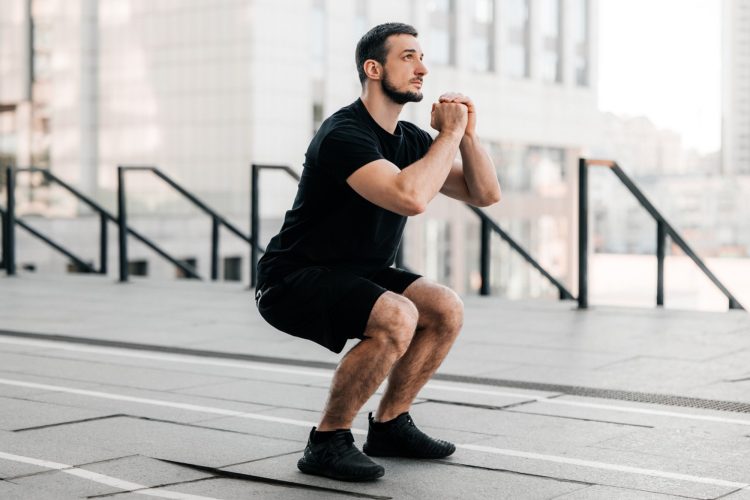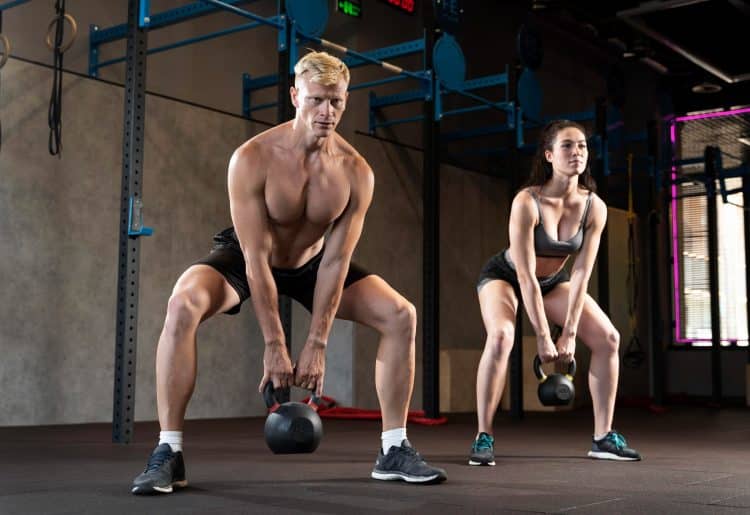As a personal trainer with over three decades of experience, I know how important time and energy are for exercise adherence. After all, as soon as a workout seems like more trouble than it’s worth, participants are quick to drop out (1).
As such, much of my job involves writing routines that slot as seamlessly into my client’s lives as possible. That means weighing up the pros and cons of various training methods and seeking the best way to meet my client’s goals.
And do you know what I’ve found?
After 30-plus years in the fitness industry, I’ve discovered there is no single best workout. In fact, almost everything works if you do it consistently.
Consequently, I’m not a calisthenics guy, a bodybuilding guy, a kettlebell guy, a cardio guy, or a functional training guy. Instead, I’m a trainer who mixes and matches training methods, picking the best tool for the task at hand.
This means the best workout is the one that most closely matches your needs and goals. Asking which workout is best puts the cart before the horse. So, tell me what you want to achieve, and then I can pick the best workout for your goals.
Level Up Your Fitness: Join our 💪 strong community in Fitness Volt Newsletter. Get daily inspiration, expert-backed workouts, nutrition tips, the latest in strength sports, and the support you need to reach your goals. Subscribe for free!
Consequently, it’s sometimes necessary to choose between two similar workouts. That’s because time and energy are limited. Trying to do too much training is as unhelpful as doing too little.
With that in mind, in this article, I compare circuit training vs. CrossFit so you can pick the option that’s right for you.
Circuit Training Basics
Circuit training is an old-school workout that’s been around since the times of ancient Rome and Greece. That said, it was extensively studied and popularized in the 1950s at Leeds University in the UK by R.E. Morgan and G.T. Anderson (2)
In its most fundamental form, circuit training is a workout where participants perform several exercises in a fixed sequence with little or no rest between each one. Exercises, called stations in circuit training, are done for reps or time, and most circuit workouts comprise several rounds, e.g., 2-5.
For example:
Move as quickly as possible between exercises, and rest for 1-2 minutes between rounds. Complete 2-4 rounds in total.
- Air squat x 20
- Push-up x 15
- Dead bug x 20
- Pull-up x 10
- Prisoner good morning x 20
- Oblique crunches x 20
- Alternating lunge x 20
- Dumbbell curl and press x 15
- Plank jacks x 20
- Jumping jacks x 20
Circuit training can involve a variety of fitness equipment, including resistance bands, freeweights, kettlebells, resistance machines, etc. However, you can also have a great workout using nothing but your body weight. Calisthenic circuits are especially popular in the military and with home exercisers.
The Benefits and Advantages of Circuit Training
Is circuit training the best workout for your needs and goals? Consider these benefits and advantages and then decide!
Weight Management – circuit training has the potential to help you lose weight and get lean (3). The non-stop nature of circuits means you’ll burn a lot of kilocalories per session. While the amount of energy used will depend on intensity and duration, with very little time spent resting, it will be higher than for conventional strength training.
Estimate how many kilocalories you’ll burn during circuit training with our easy-to-use calculator.
All-Around Fitness – cardio exercise improves cardiovascular fitness, and lifting weights builds muscle and strength. In contrast, circuit training does both at the same time (4). As such, circuits are perfect for exercise generalists who want to improve their cardiovascular and muscular fitness.
Time-Efficient Workouts – circuits combine the benefits of cardio and strength training in the same workouts. Consequently, you won’t need to exercise as often to achieve similar results. This represents a significant time saving that most busy exercisers will appreciate.
Highly Modifiable – you can adapt circuit training for almost any goal and fitness level. As such, it’s suitable for a wide range of exercisers, from beginners to elite. Modifiable elements of circuit workouts include:
- Exercise difficulty
- Number of exercises per workout
- Duration/number of reps
- Load
- Proximity to failure
- Rest between exercises
- Number of rounds
- Rest between rounds
Such flexibility means that circuit training can always be adapted to meet your needs and abilities. As an added advantage, it also means you can keep your workouts varied and interesting. Eliminating boredom is a big step toward improving exercise adherence.
Related: What is Circuit Training? The Ultimate Guide to Get Lean
What is CrossFit
Where circuit training is a type of workout, CrossFit is an entire training philosophy and a competitive sport. It was invented in 2000 and quickly became the fastest-growing, most popular exercise program around.
But what is CrossFit?
CrossFit is a form of high-intensity cross-training that involves different workouts to target all the components of fitness. A CrossFit Workout is called a WOD, which is short for Workout of the Day.
Depending on the day, a CrossFit WOD could involve:
- Running
- Rowing
- Jump rope
- Calisthenics
- Gymnastics
- Olympic weightlifting
- Powerlifting
- Kettlebells
- Rope climbs
- Medicine balls
- Functional strength training
New exercises and training methods are always being added, making CrossFit workouts incredibly varied. As such, CrossFit aims to develop a high level of all-around fitness and strength. Workouts are often against the clock, and participants are encouraged to beat their previous records.
Level Up Your Fitness: Join our 💪 strong community in Fitness Volt Newsletter. Get daily inspiration, expert-backed workouts, nutrition tips, the latest in strength sports, and the support you need to reach your goals. Subscribe for free!
While some WODs occur infrequently, others are so-called benchmark workouts. These are standardized across all CrossFit gyms, which are called boxes. These benchmark workouts allow CrossFitters to compare their fitness to exercisers all around the world.
CrossFit is very popular with general exercisers and athletes from many sports. Some Participants become CrossFit specialists and train to compete in functional fitness events. The military are also fans of CrossFit, as the WODs develop the kind of all-around fitness that soldiers and special forces operatives need.
Here are a couple of example WODs to try:
“Cindy”
Complete as many rounds as possible in 20 minutes:
- 5 pull-ups
- 10 push-ups
- 15 air squats
“Murph”
For Time:
- 1-mile run
- 100 pull-ups
- 200 push-ups
- 300 air squats
- 1-mile run
“CrossFit Total”
Find a 1-rep max for each of the following lifts:
- Back squat
- Shoulder press (strict press)
- Deadlift
Related:
- Best Endurance CrossFit Workouts to Become Fitter
- Top 10 Effective CrossFit Bodyweight Workouts
- Try These Awesome CrossFit Home Workouts
The Benefits and Advantages of CrossFit
Is CrossFit worth your time and energy? Consider these benefits and advantages and then decide!
Weight Management – like any form of exercise, CrossFit workouts burn kilocalories, which can help you lose fat or maintain your weight. However, the actual amount of energy burned during CrossFit will depend on the WOD you are doing and how hard you work. Studies suggest that CrossFit can be an effective way to burn fat and lose weight (5).
All-Around Fitness – CrossFit WODs are highly varied, with different demands each day. This means you could be lifting weights one day and running the next. As such, CrossFit has the potential to build a very high level of all-around fitness. CrossFit will develop (6):
- Strength
- Power
- Endurance
- Aerobic fitness
- Anaerobic fitness
- Flexibility/mobility
- Balance
- Coordination
- Skill
Strong Competitive Element – even if you never enter the CrossFit games, competition is an almost unavoidable part of most WODs. Participants are encouraged to beat their previous records and compare their performance with other CrossFitters. This will appeal to anyone with a strong competitive drive and is something that many CrossFitters find motivating.
Very Varied Workouts – while the benchmark WODs are a staple of CrossFit training, many of the workouts are more diverse and random, providing plenty of training variation (7). As such, CrossFit is a good option for exercisers who get bored doing the same routine over and over.
Sense of Community and Support – while you can do CrossFit at home or in a conventional gym, most CrossFitters belong to Boxes or attend group classes. WODs are performed in groups, adding to the element of competition. There is also a strong online community. This sense of belonging and support can enhance motivation and improve adherence.
FAQ’s
Do you have a question about circuit training vs. CrossFit? No problem, because I’ve got the answers. But if you want more information, please drop me a line in the comments section below, and I’ll get back to you ASAP.
1. Which is best for weight loss – circuit training or CrossFit
Both of these workouts have a high energy cost. As such, circuit training and CrossFit could help you maintain or lose weight. That said, if you are serious about getting and staying lean, you must also pay attention to your diet. Poor eating habits could derail your attempts to control your weight regardless of your chosen workout.
2. Is circuit training or CrossFit best for building muscle?
As studies show, you can build muscle with circuit training (3, 4). However, CrossFit is potentially better for muscle building as it utilizes heavier weights and higher-intensity workouts. It’s no coincidence that many top CrossFit performers are so jacked!
3. Is circuit training or CrossFit best for beginners?
Both workouts are modifiable for beginners. As such, they’re both suitable for beginners. That said, CrossFit WODs often involve technically demanding exercises, such as Olympic clean and jerks, handstand push-ups, and other challenging movements. These exercises can take a long time to master.
So, while there are WODs that are suitable for beginners, many are not. In contrast, all circuit workouts can be modified for beginners. This means that circuit training is potentially a little more accessible for novices.
4. Are CrossFit and circuit training the same thing?
While CrossFit and circuit training share many features and benefits, they are not the same. Where circuit training is a type of workout, CrossFit is more of a workout system or philosophy. In fact, some CrossFit workouts are based on circuit training, while others are not.
So, no, CrossFit and circuit training are not the same thing, but they do share some similarities.
5. Which is best for home workouts – circuit training or CrossFit?
Many WODs require specialist equipment, which is only available at CrossFit Boxes. However, there are some low-tech and bodyweight WODs that you can do at home. In contrast, you can create circuit training workouts based on whatever equipment you have available.
So, while you can do CrossFit and circuit training at home, circuits are probably the most home-friendly workout option as there is no set equipment requirement.
Circuit Training vs. CrossFit – Conclusion
Circuit training is widely accessible and offers a broad range of workout options to help you reach almost any fitness goal. In contrast, CrossFit is an intense, challenging strength and conditioning program that is also a sport.
Is one better than the other?
The answer to that question depends on what you want to get from your workouts. Circuit training and CrossFit have advantages and benefits, so you must choose the one that best aligns with your health and fitness goals.
Ultimately, the best training method is the one that you enjoy and can consistently stick to. After all, the key to fitness progress is consistency. Even the best workout in the world won’t help you if you don’t do it regularly.
Related:
- Circuit Training vs. Cross Training: Definitions, Benefits, and Which One Should You Do?
- Circuit Training vs. HIIT For Fitness and Fat Loss
References:
- Rodrigues F, Teixeira DS, Neiva HP, Cid L, Monteiro D. Understanding Exercise Adherence: The Predictability of Past Experience and Motivational Determinants. Brain Sci. 2020 Feb 12;10(2):98. doi: 10.3390/brainsci10020098. PMID: 32059352; PMCID: PMC7071831.
- University of New Mexico: New Insights into Circuit Training, Len Kravitz, Ph.D.
- Sperlich B, Wallmann-Sperlich B, Zinner C, Von Stauffenberg V, Losert H, Holmberg HC. Functional High-Intensity Circuit Training Improves Body Composition, Peak Oxygen Uptake, Strength and Alters Certain Dimensions of Quality of Life in Overweight Women. Front Physiol. 2017 Apr 3;8:172. doi: 10.3389/fphys.2017.00172. PMID: 28420999; PMCID: PMC5376588.
- Muñoz-Martínez FA, Rubio-Arias JÁ, Ramos-Campo DJ, Alcaraz PE. Effectiveness of Resistance Circuit-Based Training for Maximum Oxygen Uptake and Upper-Body One-Repetition Maximum Improvements: A Systematic Review and Meta-Analysis. Sports Med. 2017 Dec;47(12):2553-2568. doi: 10.1007/s40279-017-0773-4. PMID: 28822112.
- Menargues-Ramírez R, Sospedra I, Holway F, Hurtado-Sánchez JA, Martínez-Sanz JM. Evaluation of Body Composition in CrossFit® Athletes and the Relation with Their Results in Official Training. Int J Environ Res Public Health. 2022 Sep 2;19(17):11003. doi: 10.3390/ijerph191711003. PMID: 36078716; PMCID: PMC9518485.
- Meyer J, Morrison J, Zuniga J. The Benefits and Risks of CrossFit: A Systematic Review. Workplace Health Saf. 2017 Dec;65(12):612-618. doi: 10.1177/2165079916685568. Epub 2017 Mar 31. PMID: 28363035.
- Claudino JG, Gabbett TJ, Bourgeois F, Souza HS, Miranda RC, Mezêncio B, Soncin R, Cardoso Filho CA, Bottaro M, Hernandez AJ, Amadio AC, Serrão JC. CrossFit Overview: Systematic Review and Meta-analysis. Sports Med Open. 2018 Feb 26;4(1):11. doi: 10.1186/s40798-018-0124-5. PMID: 29484512; PMCID: PMC5826907.










